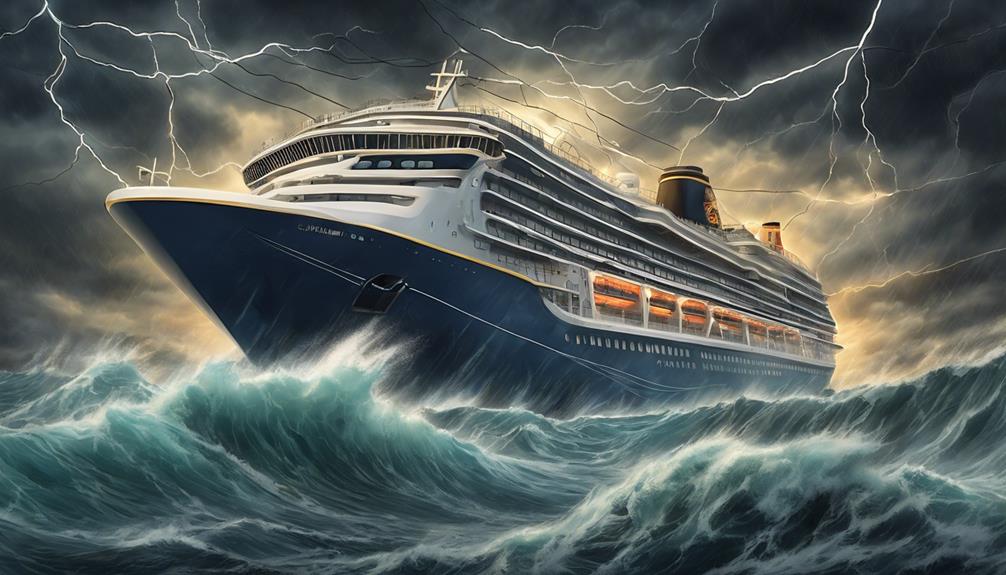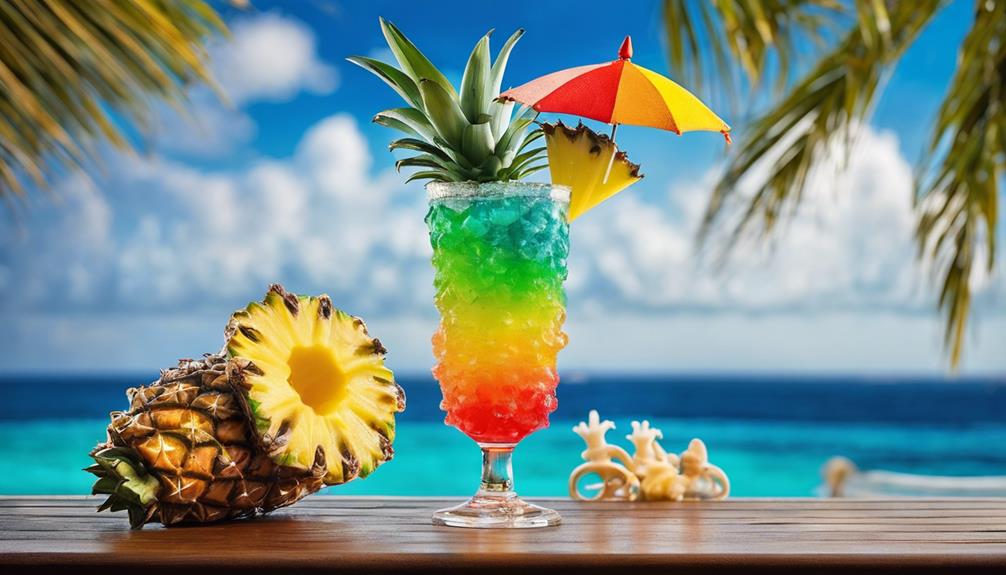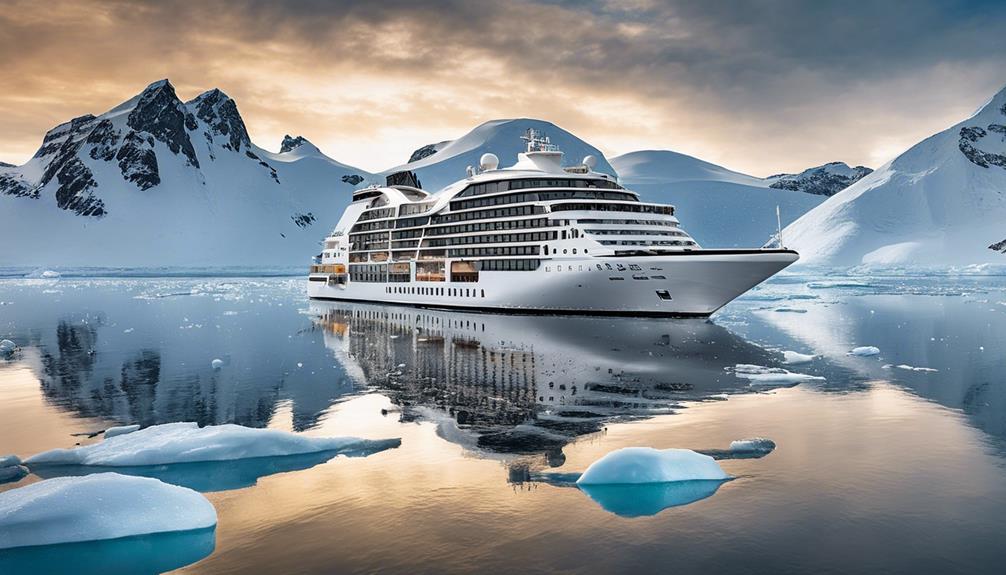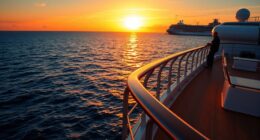Facing a storm during a cruise might bring about concern, yet having the right preparations can greatly enhance the safety of the voyage. It’s crucial to educate oneself on common storm conditions and understand the safety measures in place. Remembering specific tips is key to safely making it through rough seas.
Stay tuned to discover valuable insights on how to stay safe and secure while on a cruise when faced with stormy weather.
Key Takeaways
- Seek shelter in cabins for safety and follow crew instructions promptly.
- Familiarize with safety equipment and emergency procedures onboard.
- Crew undergo rigorous training to manage emergencies efficiently.
- Prioritize passenger safety and adapt swiftly to changing weather conditions.
Common Storm Scenarios on Cruises
Encountering ferocious seas is a common challenge for cruise ships along various routes, especially during specific seasons and in particular regions. Rough seas can test the mettle of even the most seasoned sailors.
Cruise ships navigating the Norwegian coast during winter face turbulent waters that demand careful navigation and experienced crews to ensure guest safety. The Drake Passage, notorious for its tumultuous conditions, presents another formidable obstacle for cruise ships en route to the Antarctic peninsula.
Caribbean cruises from June to November must contend with the unpredictable nature of the hurricane season, prompting cruise lines to monitor weather conditions closely for the safety of passengers. North Atlantic storms from September to February and stormy conditions in the Bay of Biscay during autumn and winter also pose challenges for cruise itineraries.
Understanding these common storm scenarios is essential for cruise operators to prioritize guest safety and adapt swiftly to changing weather conditions.
Safety Measures During Storms
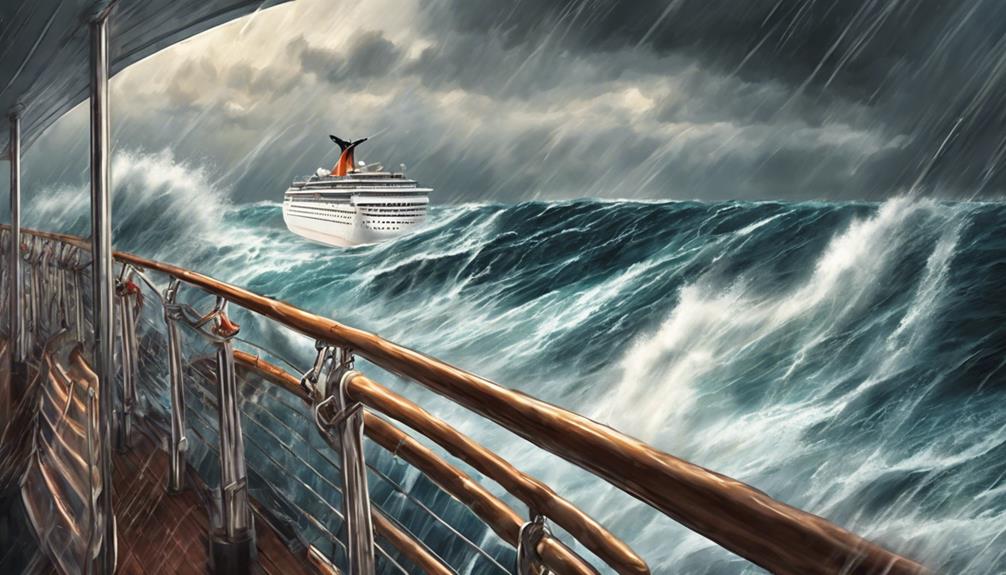
During storms at sea, it's crucial to seek shelter in cabins to stay safe and secure.
Avoiding open decks and following crew instructions promptly are essential for ensuring the well-being of all passengers.
These measures help minimize risks and maintain a controlled environment during challenging weather conditions.
Sheltering in Cabins
When seeking safety and comfort during storms at sea, it's essential to remain in your cabin. Cabins are specifically designed to withstand rough seas, providing a secure environment for passengers.
By sheltering in cabins, you can avoid the dangers of going out on decks or open areas, reducing the risk of accidents or injuries. It's crucial to follow crew instructions and safety protocols while staying in your cabin to ensure everyone's well-being.
Despite the stormy weather outside, you can still enjoy activities like reading, relaxing, or watching movies in the comfort of your cabin. Remember, staying inside your cabin is the best way to stay safe and protected during a storm at sea.
Avoiding Open Decks
To ensure safety during storms at sea, one must prioritize avoiding open decks on a cruise to minimize exposure to hazardous conditions. When facing rough weather on a cruise ship, staying away from open decks is crucial for your well-being. Here are three essential tips to help you stay safe:
- Utilize Indoor Areas: Seek shelter in designated indoor areas or cabins to protect yourself from the harsh weather elements.
- Follow Crew Instructions: Crew members may restrict access to open decks during severe weather for passenger safety. Adhering to their guidance is vital.
- Stay Informed: Keep yourself updated on the weather conditions and safety protocols while onboard to make informed decisions for your safety.
Following Crew Instructions
Implementing the safety measures instructed by the crew is paramount for ensuring the well-being of passengers during storms on a cruise ship. By following crew instructions promptly and precisely, passengers can contribute to their safety and that of others on board. Crew members are extensively trained to handle rough seas and will provide regular updates to keep everyone informed and calm.
It's essential to secure loose items, listen carefully to safety briefings, and cooperate with the crew's directives. During stormy weather, some attractions or outdoor areas may be closed to prevent accidents and ensure passenger safety. Trusting the expertise of the crew, staying informed, and adhering to their instructions are key aspects of staying safe during challenging weather conditions at sea.
Importance of Following Crew Instructions
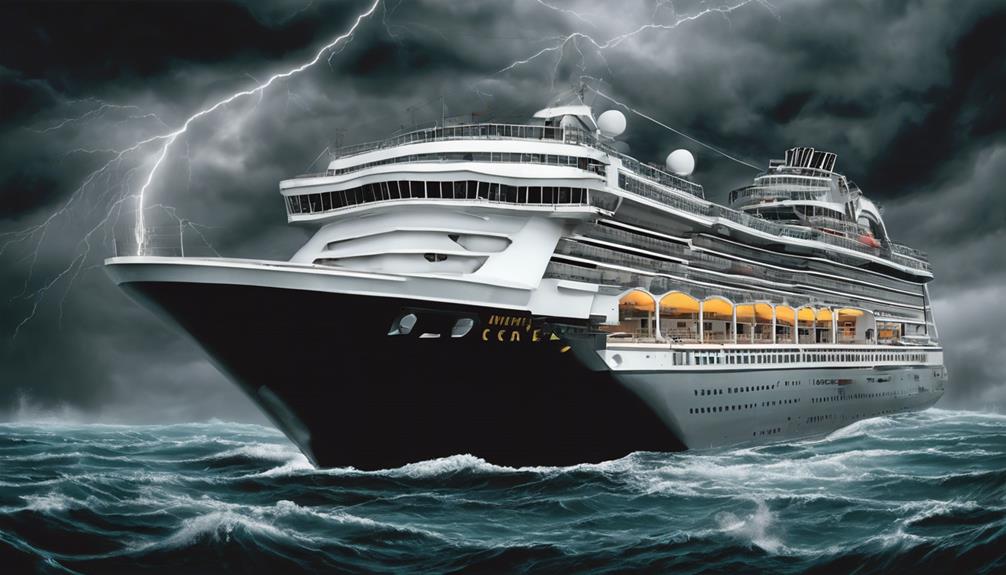
Ensuring passenger safety and minimizing risks during a storm on a cruise heavily relies on heeding and following crew instructions diligently. When facing stormy conditions at sea, the importance of adhering to crew directives can't be overstated. Here are three key reasons why following crew instructions is crucial:
- Expert Guidance: Crew members undergo extensive training to handle storm situations effectively. Their experience and knowledge equip them to navigate through challenging conditions and ensure the safety of passengers.
- Maintaining Order: Crew announcements and safety protocols play a vital role in maintaining order and facilitating a coordinated response during storms. By following these instructions, passengers contribute to the overall safety and well-being of everyone on board.
- Effective Navigation: Trusting and complying with crew directives enable passengers to navigate storm challenges efficiently. By working together with the crew, passengers can enhance their safety and security while onboard.
Precautionary Steps for Passengers
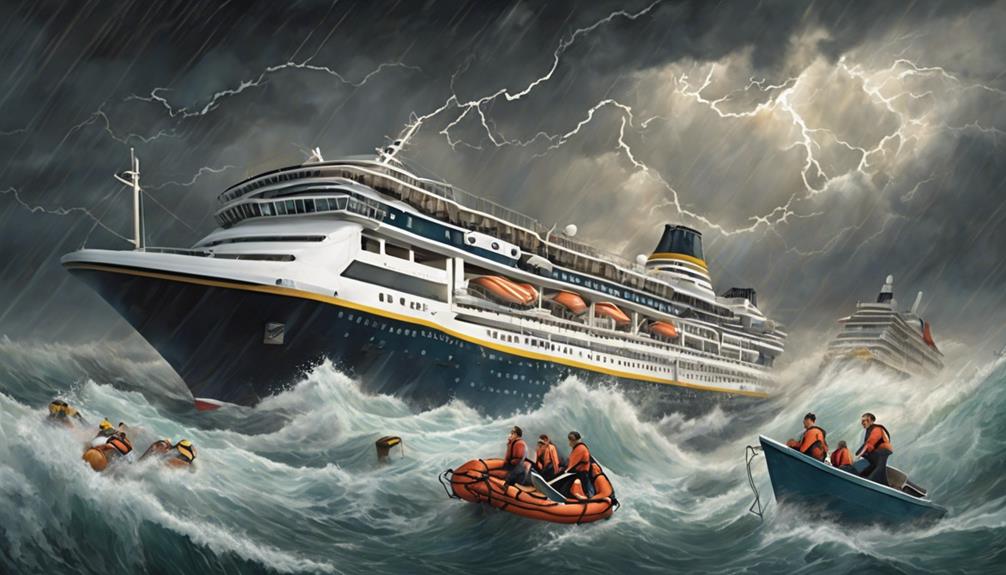
When preparing for potential storms while on a cruise, it's crucial to be aware of safety equipment availability and emergency evacuation procedures.
As passengers, we should familiarize ourselves with the location of life jackets, emergency exits, and muster stations.
Understanding these precautionary measures can help ensure a safer experience on board in challenging weather conditions.
Safety Equipment Availability
Upon boarding a cruise ship, passengers are promptly acquainted with the locations and procedures regarding safety equipment, such as life jackets and lifeboats, ensuring preparedness in case of emergencies. Safety drills are conducted to familiarize passengers with these protocols.
Here are three key points regarding safety equipment availability on cruise ships:
- Clear Instructions: Passengers receive clear instructions on how to locate and properly use safety equipment, ensuring they're prepared in the event of an emergency.
- Regulatory Compliance: Cruise ships adhere to international maritime regulations regarding the availability and maintenance of safety equipment, guaranteeing that passengers are protected during storms.
- Crew Preparedness: Crew members undergo rigorous training to efficiently handle safety equipment and ensure the well-being of all passengers.
Emergency Evacuation Procedures
In the event of a storm while on a cruise, passengers must promptly follow crew instructions and proceed calmly to designated muster stations for further assistance.
Emergency evacuation procedures on cruise ships are meticulously planned, with passengers receiving detailed information on evacuation routes, life jackets, and safety procedures.
Crew members are extensively trained to ensure a smooth evacuation process and provide assistance to passengers as needed.
Evacuation drills are conducted at the start of each cruise to familiarize passengers with the necessary protocols in case of adverse weather conditions.
It's crucial for passengers to remain calm, cooperate with the crew, and adhere to safety guidelines during emergency evacuations to ensure the well-being of everyone on board.
Evacuation Protocols on Cruise Ships
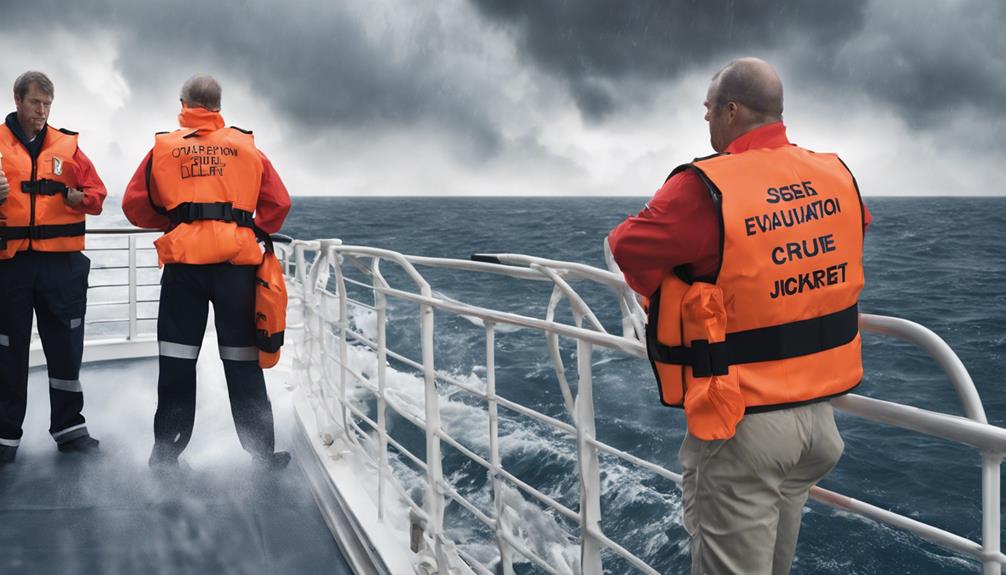
Evacuation protocols on cruise ships are meticulously designed to ensure the safety and well-being of both passengers and crew during stormy weather conditions. Here are three key aspects of these protocols:
- Clear Evacuation Routes: Cruise ships have clearly marked evacuation routes throughout the vessel to guide individuals to designated assembly points. This strategic placement helps passengers and crew navigate safely even in challenging conditions.
- Mandatory Safety Drills: Passengers are required to participate in safety drills at the beginning of the cruise. These drills familiarize individuals with evacuation procedures, ensuring they can respond effectively in case of an emergency.
- Crew Training: Crew members undergo rigorous training to efficiently manage emergency situations and assist passengers during evacuations. This training equips them with the skills and knowledge necessary to handle various scenarios that may arise while at sea.
In emergency situations, the captain may use their discretion to initiate evacuation procedures based on the severity of the weather conditions, prioritizing the safety of everyone on board.
Communication Channels During Storms
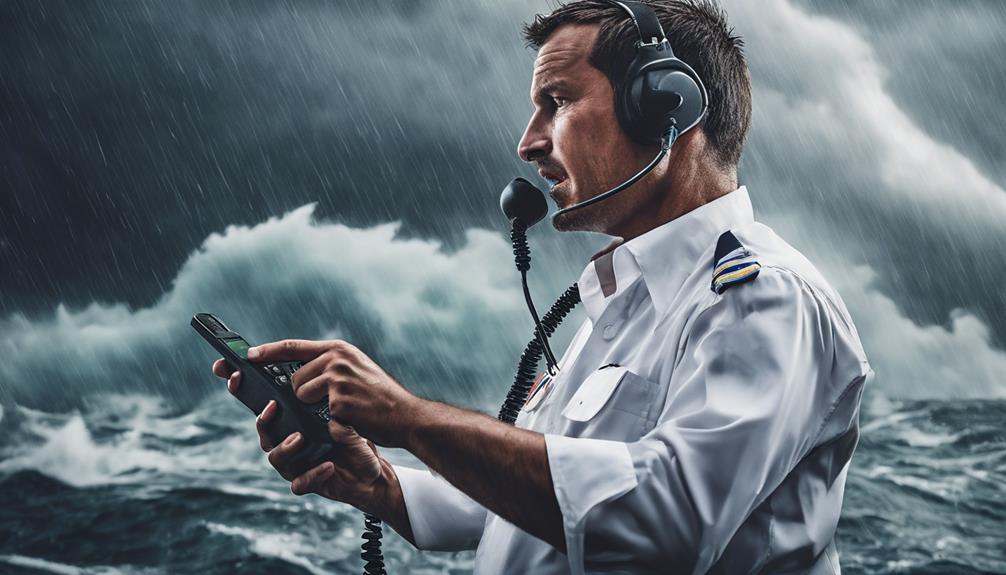
During stormy conditions on a cruise ship, maintaining clear and effective communication channels is crucial for ensuring the safety and well-being of passengers and crew. Cruise ships utilize various communication methods to keep everyone informed and safe. The captain's announcements provide regular updates on the weather and any necessary route changes. Passengers receive alerts through onboard communication systems, ensuring they stay informed about the changing conditions. Safety information and emergency procedures are communicated through the ship's intercom system and cabin TVs, allowing everyone to be aware of what actions to take in case of an emergency. Crew members undergo training to effectively communicate with guests during storms, ensuring that information is relayed efficiently. Clear communication channels are essential for implementing emergency procedures and evacuation plans, ultimately prioritizing the safety of all individuals on board.
| Communication Channels | Example | Importance |
|---|---|---|
| Captain's Announcements | Updates on weather conditions and route changes | Keeps passengers informed |
| Onboard Communication Systems | Weather alerts and emergency information | Ensures passengers are aware of situations |
| Safety Information | Shared through intercoms and cabin TVs | Informs passengers about emergency procedures |
Frequently Asked Questions
Can a Cruise Ship Tip Over in a Storm?
Yes, cruise ships have a low center of gravity, ballast tanks, and stabilizing technology to prevent tipping over in storms. They are designed to withstand extreme weather conditions. Experienced captains and crew ensure passenger safety by navigating effectively.
Is It Safe to Be on a Cruise Ship During a Storm?
It's safe to be on a cruise ship during a storm. Ships are built to handle rough seas, and captains monitor weather closely. Safety precautions, like non-slip mats, are in place. Follow crew instructions for a secure voyage.
How Do Ships Not Tip Over in Storms?
We stay upright in storms due to heavy steel hulls and strategic weight distribution. Stabilizing technology and rigorous testing ensure our ship's stability. Advanced stabilizers reduce rolling for comfort. Our design meets safety standards to navigate storms safely.
How Do Cruise Ships Survive Storms?
In the eye of the storm, cruise ships become fortresses, braving fierce winds and turbulent seas. Thick steel hulls, skilled crew, stabilizers, and advanced tech ensure our safety. We navigate through storms with confidence and care.
Conclusion
As the storm clouds loom overhead and the sea churns beneath us, remember to batten down the hatches and stay safe onboard. Just like a sturdy ship navigating through rough waters, we must remain vigilant and follow protocol to weather the storm.
With clear communication and a calm demeanor, we can sail through any turbulence that comes our way. Stay steady, stay informed, and let's ride out the storm together.
Smooth sailing awaits on the other side.

